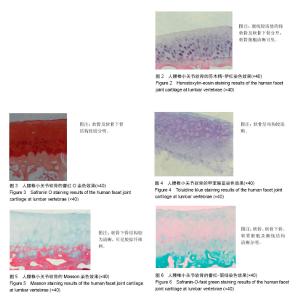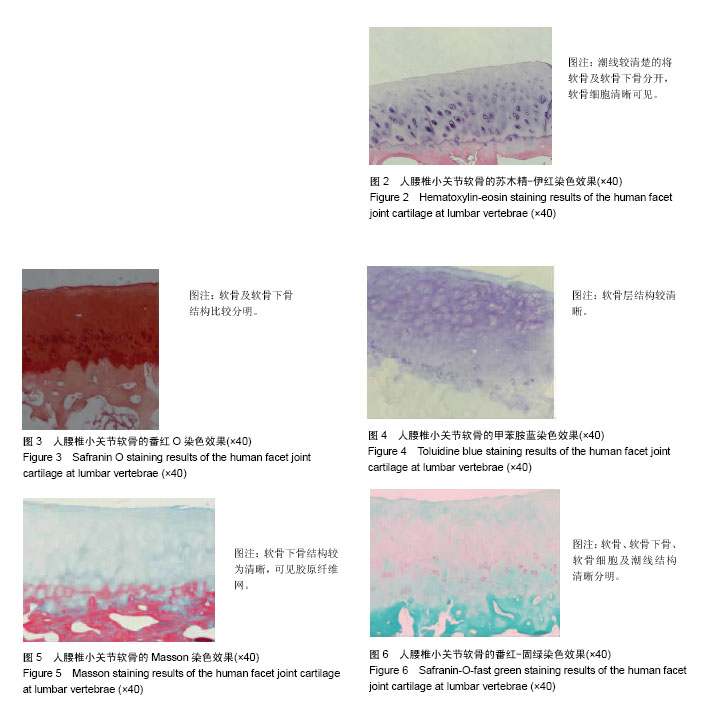| [1] Zhou X, Liu Y, Zhou S, et al. The correlation between radiographic and pathologic grading of lumbar facet joint degeneration. BMC Med Imaging. 2016;16:27. [2] Knecht S, Vanwanseele B, Stüssi E. A review on the mechanical quality of articular cartilage - implications for the diagnosis of osteoarthritis. Clin Biomech (Bristol, Avon). 2006;21(10):999-1012. [3] Byers PD, Brown RA. Cell columns in articular cartilage physes questioned: a review. Osteoarthritis Cartilage. 2006; 14(1):3-12. [4] Lewin T. Osteoarthritis in lumbar synovial joints. A morphologic study. Acta Orthop Scand Suppl. 1964:Suppl 73:1-112.[5] 严望军,李家顺,贾连顺.腰椎关节突关节骨性关节炎的病因学[J].脊柱外科杂志,2003,1(4):240-242. [6] Colini-Baldeschi G. Evaluation of pulsed radiofrequency denervation in the treatment of chronic facetjoint pain: an observational study. Anesth Pain Med. 2012;1(3):168-173. [7] 何飞宇,石磊,陈海等.腰椎小关节骨性关节炎的病理学及影像学对比研究[J].创伤外科杂志,2012,11(3):247-249.[8] Im GI, Shin SR. Changes in the production and the effect of nitric oxide with aging in articular cartilage: an experimental study in rabbits. Acta Orthop Scand. 2002;73(1):6-10.[9] 苏杨,王江玥,刘静.老年腰椎小关节骨性关节炎软骨退变病理与影像学改变相关性研究[J].海南医学 2016,27(11):1818-1821.[10] Ji H, Li J, Shao J, et al. Histopathologic comparison of condylar hyperplasia and condylar osteochondroma by using different staining methods. Oral Surg Oral Med Oral Pathol Oral Radiol. 2017;123(3):320-329. [11] 杨瑞甫,胡蕴玉,吴银松,等.兔骨关节炎两种动物模型的比较[J].中国矫形外科杂志,2006,14(19):1497-1499.[12] 黄云梅,陈文列,黄美雅,等.多种特殊染色法在骨关节炎组织形态学研究中的应用比较[J].中国比较医学杂志,2011,21(5):45-48.[13] 姬瑞娟,孙爱军,施丽英,等.番红O-固绿染色在关节组织学应用的改进[J],解剖学杂志,2011,34(5):716-718.[14] 候玉红.番红花精O软骨染色法的改良[J].实用口腔医志, 1986, 2(2):126-127.[15] Erenpreisa J, Freivalds T. Anisotropic staining of apurinic acid with toluidine blue. Histochemistry. 1979;60(3):321-325.[16] Landemore G, Quillec M, Oulhaj N, et al. Kurloff cell ultrastructure after combined formaldehyde-cetylpyridinium chloride fixation and high-iron diamine staining. Histochem J. 1993;25(1):64-76.[17] Mello ML. Toluidine blue binding capacity of heterochromatin and euchromatin of Triatoma infestans Klug. Histochemistry. 1980;69(2):181-187.[18] 曹稳根,陈雷,焦庆才,等.硫酸软骨素与天青A空间定向相互作用机理的研究[J].光谱学与光谱分析,2003,23(3):587-590. [19] Lillie RD, Conn HJ. Conn’ s Biological Stains. The William and Wilkins Company. 1977. [20] Lyons TJ, Stoddart RW, McClure SF, et al. The tidemark of the chondro-osseous junction of the normal human knee joint. J Mol Histol. 2005;36(3):207-215.[21] 李红芬,郑肇巽,马品耀,等.HE染色原理和试剂配制及染色过程中的若干问题的探讨[J].医学信息,2011,24(7):1985-1986.[22] 王吉兴,姚军.SV40LTAg基因永生化软骨细胞体外培养的生物学特性[J].第一军医大学学报,2003,23(12):1338-1340.[23] Han TL, Wang M, Yan X Y, et al. Decreased expression of type I collagen and dentin phosphoprotein in teeth of fluorosed sheep. Fluoride. 2010;43(1):19-24. [24] Kim J, Kim IS, Cho TH, et al. In vivo evaluation of MMP sensitive high-molecular weight HA-based hydrogels for bone tissue engineering. J Biomed Mater Res A. 2010; 95(3): 673-681. [25] 于斐,雷鸣,曾晖,等.特殊染色技术在骨关节炎关节软骨形态学研究中的比较[J].中国矫形外科杂志,2015,23(19):1801-1807. [26] Lyons TJ, Stoddart RW, McClure SF, et al. The tidemark of the chondro-osseous junction of the normal human knee joint. J Mol Histol. 2005;36(3):207-215. [27] Daubs BM, Markel MD, Manley PA. Histomorphometric analysis of articular cartilage, zone of calcified cartilage, and subchondral bone plate in femoral heads from clinically normal dogs and dogs with moderate or severe osteoarthritis. Am J Vet Res. 2006;67(10):1719-1724.[28] 陶云霞,王根林,袁鹏,等.两种染色法判定左前臂骨缺损修复骨组织的成熟度[J].中国组织工程研究,2012,16(37):6841-6845.[29] Wang W, Xu J, Kirsch T. Annexin-mediated Ca2+ influx regulates growth plate chondrocyte maturation and apoptosis. J Biol Chem. 2003;278(6):3762-3769. [30] Frisbie DD, Cross MW, McIlwraith CW. A comparative study of articular cartilage thickness in the stifle of animal species used in human pre-clinical studies compared to articular cartilage thickness in the human knee. Vet Comp Orthop Traumatol. 2006;19(3):142-146.[31] Burr DB. Anatomy and physiology of the mineralized tissues: role in the pathogenesis of osteoarthrosis. Osteoarthritis Cartilage. 2004;12 Suppl A:S20-30. [32] Tuncay IC, Ozdemir BH, Demirörs H, et al. Pedunculated synovium grafts in articular cartilage defects in rabbits. J Invest Surg. 2005;18(3):115-122. [33] 王富友,杨柳,段小军,等.正常膝关节软骨钙化层形态结构研究[J].中国修复重建外科杂志,2008,22(5):524-527. [34] Gavaia PJ, Sarasquete C, Cancela ML. Detection of mineralized structures in early stages of development of marine Teleostei using a modified alcian blue-alizarin red double staining technique for bone and cartilage. Biotech Histochem. 2000;75(2):79-84.[35] Li X, Lang W, Ye H, et al. Tougu Xiaotong capsule inhibits the tidemark replication and cartilage degradation of papain-induced osteoarthritis by the regulation of chondrocyte autophagy. Int J Mol Med. 2013;31(6):1349-1356. [36] Luo HM, Xiao F, Li XG, et al. P4-335 Regulation of ginsenoside Rg1 on the APP and neprilysin expression induced by lipopoly saccharide in C6 cell line. Neurobiol Aging. 2004;25(4):S570. [37] Knecht S, Vanwanseele B, Stüssi E. A review on the mechanical quality of articular cartilage - implications for the diagnosis of osteoarthritis. Clin Biomech (Bristol, Avon). 2006;21(10):999-1012. [38] Chiu RC. Therapeutic cardiac angiogenesis and myogenesis: the promises and challenges on a new frontier. J Thorac Cardiovasc Surg. 2001;122(5):851-852.[39] Boodhwani M, Sellke FW. Myometrium: another candidate for cell-based myocardial angiogenesis. Am J Physiol Heart Circ Physiol. 2006;291(5):H2039-2040.[40] Camplejohn KL,Allard SA.Limitations of safranin‘ o’ staining in proteoglycan-depleted cartilage demonstrated with monoclonal antibodies.Histochemistry.1988;89(2):185-188. [41] Yamada K, Healey R, Amiel D, et al. Subchondral bone of the human knee joint in aging and osteoarthritis. Osteoarthritis Cartilage. 2002;10(5):360-369.[42] 王玉芳,徐晓艳,武彦.常用的特殊染色在病理诊断中的应用[J].实用医技杂志,2013,20(12):1357-1361.[43] 江晓红.三种改良的特殊染色方法[J].现代中西医结合杂志,2004, 13(6):812.[44] Martin I, Obradovic B, Freed LE, et al. Method for quantitative analysis of glycosaminoglycan distribution in cultured natural and engineered cartilage. Ann Biomed Eng. 1999;27(5):656-662. [45] Király K, Lapveteläinen T, Arokoski J, et al. Application of selected cationic dyes for the semiquantitative estimation of glycosaminoglycans in histological sections of articular cartilage by microspectrophotometry. Histochem J. 1996;28(8):577-590.[46] Kiviranta I, Jurvelin J, Tammi M, et al.Microspectro photometric quantitation of glycosaminoglycans in articular cartilage sections with Safranin O.Histochemistry. 1985; 82(3):249-255. |

